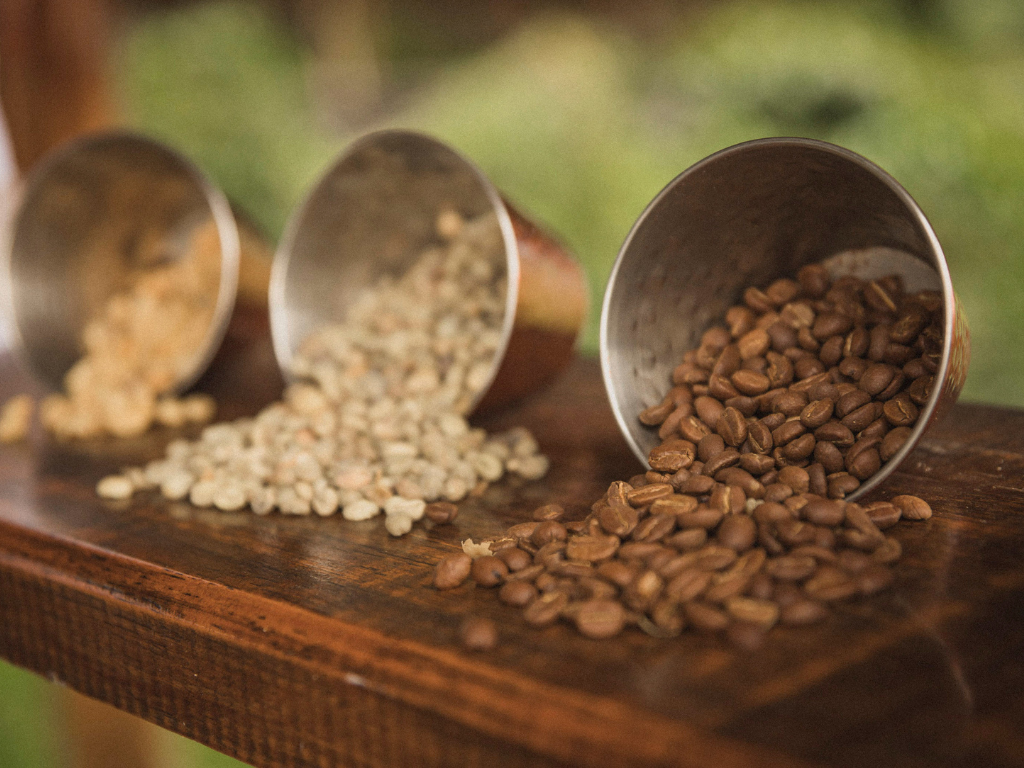When choosing coffee, most people look at origin or flavor notes—but one of the most important decisions you’ll make is the roast level. Whether you prefer a bright, fruity light roast or a bold, smoky dark roast, understanding the roasting process is key to picking coffee that matches your taste.
In this guide, we’ll explain the differences between light, medium, and dark roasts, how they affect flavor, aroma, body, and acidity, and which brewing methods work best with each type.
What is coffee roasting?
Roasting is the process of heating green coffee beans to transform them into the aromatic brown beans we grind and brew. As the beans roast, they undergo chemical changes:
- Moisture evaporates
- Sugars caramelize
- Acids break down or develop
- Aromatic oils are released
- The bean’s structure expands and cracks
The degree of roast—how long and how hot the beans are roasted—determines much of the final flavor profile.
Coffee roasters typically define three main roast levels: light, medium, and dark, with many variations in between.
Let’s explore them one by one.
Light Roast
Color: Light brown
Surface: Dry, no visible oil
Flavor: Bright, acidic, fruity, floral
Body: Light to medium
Acidity: High
Best for: Pour-over, AeroPress, drip
Light roasts retain more of the bean’s original character, making them popular in specialty coffee. They often showcase origin flavors, such as:
- Citrus and berry notes (Ethiopia, Kenya)
- Floral aromas (Yirgacheffe, Panama)
- Tea-like qualities (Rwanda, Tanzania)
Light roasts are roasted to around 356–401°F (180–205°C) and pulled after the first crack—a popping sound indicating bean expansion.
Good for:
- People who enjoy complexity, fruitiness, and acidity
- Manual brewing methods that highlight nuance (V60, Chemex)
Watch out for: Underdeveloped light roasts can taste sour or grassy
Medium Roast
Color: Medium brown
Surface: Dry or slightly oily
Flavor: Balanced, sweet, nutty, chocolatey
Body: Medium
Acidity: Moderate
Best for: Drip, pour-over, French press
Medium roasts are often the most approachable and versatile, offering a balance between the original bean flavor and roast development.
You’ll taste:
- Caramel and brown sugar
- Nutty and cocoa undertones
- Subtle fruit or spice in the background
Roasted to around 410–428°F (210–220°C), medium roasts are pulled after first crack but before second crack begins.
Good for:
- Those who enjoy sweet, smooth coffee
- Brewers who want consistency and crowd-pleasing results
Watch out for: Loss of delicate acidity in some origins
Dark Roast
Color: Dark brown to almost black
Surface: Oily, shiny
Flavor: Bitter, smoky, roasted, sometimes spicy
Body: Full
Acidity: Low
Best for: Espresso, moka pot, French press
Dark roasts emphasize the roast itself more than the origin of the beans. The flavor is dominated by:
- Toasted nuts
- Bittersweet chocolate
- Smoke or char
- Spice or woodiness
Roasted to 437–450°F (225–232°C) or beyond, dark roasts are pulled after second crack, when beans start breaking down further and oils emerge.
Good for:
- Fans of bold, rich, low-acid coffee
- Milk-based drinks like lattes and cappuccinos
Watch out for: Over-roasted beans can taste burnt or hollow
Roast level comparison chart
| Roast Level | Acidity | Body | Flavor Notes | Bean Appearance |
|---|---|---|---|---|
| Light | High | Light | Fruity, floral, tea-like | Dry, pale brown |
| Medium | Medium | Medium | Sweet, nutty, balanced | Dry, medium brown |
| Dark | Low | Full | Smoky, chocolatey, bitter | Oily, dark brown/black |
Specialty terms you might see
Some roasters use creative or old-school terms to describe roast levels:
- Cinnamon Roast – very light
- City Roast – light to medium
- Full City – medium-dark
- Vienna Roast – between medium-dark and dark
- French Roast – very dark
- Italian Roast – darkest, nearly burnt
These vary by roaster, so always check descriptions or ask for details.
Choosing the right roast for your taste
Your ideal roast depends on personal preference. Here’s a quick guide:
- Love brightness and fruity complexity? → Light roast
- Want something balanced and sweet? → Medium roast
- Prefer bold and intense with less acidity? → Dark roast
If you’re unsure, start with a medium roast and explore from there.
Also, roast level can highlight different aspects of the same bean. For example, an Ethiopian light roast might taste like berries and flowers, while the same bean in dark roast could taste smoky and bittersweet.
Roast level and brewing method
Some roast levels shine best with certain brew methods:
- Light roast → Pour-over, AeroPress, cold brew
- Medium roast → Drip, French press, espresso
- Dark roast → Espresso, moka pot, milk-based drinks
Light roasts benefit from longer, slower brewing to extract delicate flavors, while dark roasts can be brewed quickly and strongly for maximum body.
How to store your roasted coffee
Roast level also impacts freshness and storage:
- Light roasts: Best within 2–3 weeks of roast date
- Dark roasts: Oils make them go stale faster—best within 1–2 weeks
Store your beans in:
- Airtight containers
- Opaque jars
- Cool, dry environments (not the fridge or freezer)
Buy smaller amounts more often to keep flavors fresh.
Final thoughts: roast level is your flavor compass
Roast level is one of the most influential factors in how your coffee tastes. By understanding the spectrum from light to dark, you gain the ability to explore coffee more intentionally—and find the sweet spot that matches your taste.
Try beans from different roast levels and origins. Compare how they brew. Take notes. Over time, you’ll develop a coffee palate that knows exactly what you like—and how to brew it just right.
